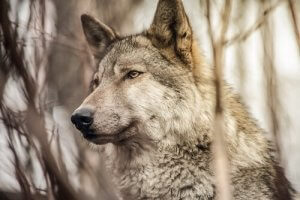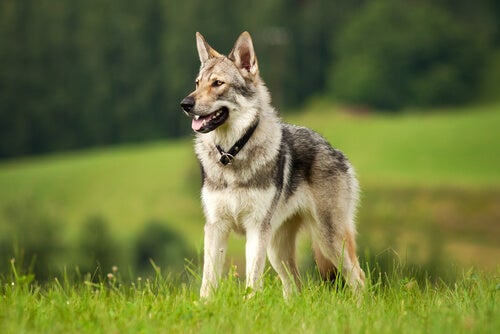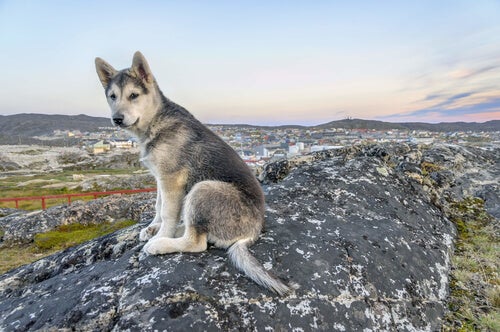Dogs and Wolves: Differences and Similarities

In previous articles, we’ve mentioned how dogs evolved from wolves. However, in spite of their similarities and the fact that both dogs and wolves are members of the same genus, Canis, they are, in fact, two separate species. Or, are they?
The clue may be in the answer to the following questions:
- Why can we tame dogs but not wolves?
- Why do dogs have the hunting wolf instinct?
We’d like to answer those and many other questions in this article. So, stick around to find out more about the specific traits of dogs and wolves.
Are dogs and wolves truly different?

In spite of their many differences, dogs still have wolf-like traits in their genes. For example, there’s their instinct to defend what belongs to them.
Even though there are many clear physical differences between these two species, their attitude and behavior are still quite similar. For example, the way they communicate with one another is typical wolf behavior.
The similarities are much more obvious in semi-wild dogs as they spend less time with people. In fact, a street animal that’s been on their own for many years and without relating to others will have wolfish gestures and demeanor.
Several thousand years ago, wolves moved near human camps to scavenge for our tasty leftovers. The subsequent process of domestication and selective breeding slowly altered their behavior, until it evolved into the animal we now know as a dog.
However, dogs and wolves are still capable of reproducing together. And, when two animals can create viable offspring, it’s because they’re members of the same species.
Dogs are highly adaptable, in fact. Thus, domesticated ones adapt quite well to any new environment. So well that they’re far removed from their original wolf ancestry.
Differences
The main differences between dogs and wolves are:
- Trust or distrust. Wolves are elusive and distrustful of everything, especially humans. It may be because of the typical harsh conditions they grow up in.
- Social capabilities. In contrast, dogs love human company and have had a special relationship with us from ancient times.
- The skull of a dog is smaller, although nobody knows why. In contrast, their chests and hips are narrow, their legs are long and their paws big. It may be that such traits help them in the wilderness. The big paws may be for running long distances at high speeds when chasing their prey.
- Wolf fangs are sharper and although one of the canine abilities is to be able to break bones with their strong jaws, the wolves’ teeth are even bigger and stronger than dogs’. Both dogs and wolves have the same amount of teeth, however.
- Eye color. This is one trait dogs and wolves don’t share. Dogs’ eyes range from blue to brown color. While wolves’ eyes are always in the range of yellow to amber. Note that their eyes are never brown.
- Their coats. Dog coats come in all sorts of colors, but wolf coats are commonly neutral colors such as white, black, gray or brown. This is because the ability to camouflage is essential to their survival.
- Tails. Wolves’ tails are straighter than dogs’.
- Also, wolves’ paws have two extra-large front toes. These are webbed for swimming and walking on snow.
- Their digestion. Scientists discovered through various tests that dogs are omnivores and can digest carbohydrates. Wolves are carnivores, 100%.
Similarities

The similarities between dogs and wolves are:
- They’re both from the family Canidae. Both animals can howl, growl and bark, although some breeds don’t, such as the Siberian Husky.
- Both subspecies hide food, mainly their leftovers. However, as a rule, wolves seldom leave any.
- Their sense of smell, sight, and hearing. Both animals have acute senses and can see clearly in the dark.
- Both dogs and wolves need to belong in a pack. They need to be with someone who is in charge. It doesn’t matter what kind of mammal they may be.
- They have the ability to communicate with any other animal through their body parts such as ears, tail, and eyes, and also via olfactory signals.
Dogs or wolves: our conclusion
In spite of all of these, there are breeds such as the German Shepherd who are clearly similar in physique to their wolf ancestors.
There are many who wonder how wolves turned into dogs. It happened because ancient humans tried to tame wolves to help them with tasks such as guarding our campsites and also as shepherds.
And so dogs emerged. Or were they, perhaps, mere wolfdogs? This was the beginning of an interspecies friendship with humans as we became close to each other and developed the relationship we currently have.
Dogs are one more member of our family and, on top of it all, they watch over us and our possessions. This is something we didn’t achieve with wolves, which is the main reason why they remained as they are.
So, the real difference between both animals is that dogs are wolves who were more submissive and compliant with us and our needs. In turn, wolves who remained wolves are the rebels who value their autonomy and independence a lot more than a tasty free meal or a place in our fireplace.
In previous articles, we’ve mentioned how dogs evolved from wolves. However, in spite of their similarities and the fact that both dogs and wolves are members of the same genus, Canis, they are, in fact, two separate species. Or, are they?
The clue may be in the answer to the following questions:
- Why can we tame dogs but not wolves?
- Why do dogs have the hunting wolf instinct?
We’d like to answer those and many other questions in this article. So, stick around to find out more about the specific traits of dogs and wolves.
Are dogs and wolves truly different?

In spite of their many differences, dogs still have wolf-like traits in their genes. For example, there’s their instinct to defend what belongs to them.
Even though there are many clear physical differences between these two species, their attitude and behavior are still quite similar. For example, the way they communicate with one another is typical wolf behavior.
The similarities are much more obvious in semi-wild dogs as they spend less time with people. In fact, a street animal that’s been on their own for many years and without relating to others will have wolfish gestures and demeanor.
Several thousand years ago, wolves moved near human camps to scavenge for our tasty leftovers. The subsequent process of domestication and selective breeding slowly altered their behavior, until it evolved into the animal we now know as a dog.
However, dogs and wolves are still capable of reproducing together. And, when two animals can create viable offspring, it’s because they’re members of the same species.
Dogs are highly adaptable, in fact. Thus, domesticated ones adapt quite well to any new environment. So well that they’re far removed from their original wolf ancestry.
Differences
The main differences between dogs and wolves are:
- Trust or distrust. Wolves are elusive and distrustful of everything, especially humans. It may be because of the typical harsh conditions they grow up in.
- Social capabilities. In contrast, dogs love human company and have had a special relationship with us from ancient times.
- The skull of a dog is smaller, although nobody knows why. In contrast, their chests and hips are narrow, their legs are long and their paws big. It may be that such traits help them in the wilderness. The big paws may be for running long distances at high speeds when chasing their prey.
- Wolf fangs are sharper and although one of the canine abilities is to be able to break bones with their strong jaws, the wolves’ teeth are even bigger and stronger than dogs’. Both dogs and wolves have the same amount of teeth, however.
- Eye color. This is one trait dogs and wolves don’t share. Dogs’ eyes range from blue to brown color. While wolves’ eyes are always in the range of yellow to amber. Note that their eyes are never brown.
- Their coats. Dog coats come in all sorts of colors, but wolf coats are commonly neutral colors such as white, black, gray or brown. This is because the ability to camouflage is essential to their survival.
- Tails. Wolves’ tails are straighter than dogs’.
- Also, wolves’ paws have two extra-large front toes. These are webbed for swimming and walking on snow.
- Their digestion. Scientists discovered through various tests that dogs are omnivores and can digest carbohydrates. Wolves are carnivores, 100%.
Similarities

The similarities between dogs and wolves are:
- They’re both from the family Canidae. Both animals can howl, growl and bark, although some breeds don’t, such as the Siberian Husky.
- Both subspecies hide food, mainly their leftovers. However, as a rule, wolves seldom leave any.
- Their sense of smell, sight, and hearing. Both animals have acute senses and can see clearly in the dark.
- Both dogs and wolves need to belong in a pack. They need to be with someone who is in charge. It doesn’t matter what kind of mammal they may be.
- They have the ability to communicate with any other animal through their body parts such as ears, tail, and eyes, and also via olfactory signals.
Dogs or wolves: our conclusion
In spite of all of these, there are breeds such as the German Shepherd who are clearly similar in physique to their wolf ancestors.
There are many who wonder how wolves turned into dogs. It happened because ancient humans tried to tame wolves to help them with tasks such as guarding our campsites and also as shepherds.
And so dogs emerged. Or were they, perhaps, mere wolfdogs? This was the beginning of an interspecies friendship with humans as we became close to each other and developed the relationship we currently have.
Dogs are one more member of our family and, on top of it all, they watch over us and our possessions. This is something we didn’t achieve with wolves, which is the main reason why they remained as they are.
So, the real difference between both animals is that dogs are wolves who were more submissive and compliant with us and our needs. In turn, wolves who remained wolves are the rebels who value their autonomy and independence a lot more than a tasty free meal or a place in our fireplace.
This text is provided for informational purposes only and does not replace consultation with a professional. If in doubt, consult your specialist.








